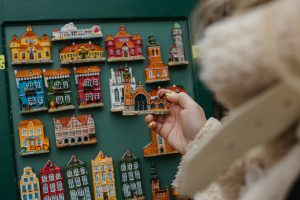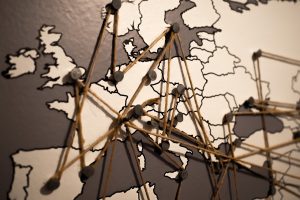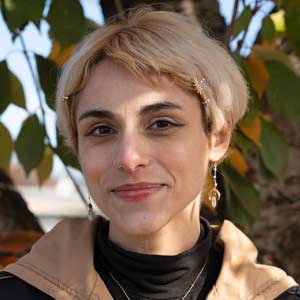When Americans think of Europe, we often picture the West — gliding through Venice on a gondola, marveling at the Eiffel Tower, or savoring a Bavarian pretzel at Oktoberfest. But, with over 50 countries, Europe is far greater than its most renowned Western destinations.
Despite their profound influence on American heritage, Eastern European nations like Poland, Ukraine, and Hungary remain underrepresented in mainstream narratives, a reality Dr. Lisa Wiśniewski recognizes firsthand.
Born in Connecticut to Polish immigrants, Dr. Wiśniewski has built her career on advocacy and representation. As a sociology professor and Goodwin University’s Faculty Senate President, she works to improve the educational landscape for first-generation students and immigrants. In her debut book, “Navigating Education as a Forgotten Immigrant: Perspectives of the Eastern European Community” (Lexington Books, February 1, 2025), Wiśniewski explores the history, culture, and educational needs of Eastern European immigrants — shedding a light not only on the experiences of Slavic-Americans, but opening doors to a broader dialogue about resilience, representation, and cross-cultural understanding.
The value of visibility

Reflecting on her childhood as a second-generation immigrant, Wiśniewski recalls a coming-of-age in which she was acutely aware of the gap between Slavic influence and representation. “Growing up, there was no one in the public eye who was Polish,” she recounts. “There wasn’t a Slavic person who was famous or well known. There were actresses like Meg Ryan, but like many other 90s celebrities, she changed her name. I often wondered, ‘Who am I going to look up to? Who’s going to tell my story?’”
When Wiśniewski began writing “Navigating Education as a Forgotten Immigrant: Perspectives of the Eastern European Community,” this sentiment served as a guidepost — inspiring her not only to share Eastern European stories but to explore why these narratives have been missing from our cultural conversations.
Question: What first inspired you to write about the experiences of Eastern European immigrants?
Lisa Wiśniewski (LW): “Many things motivated me to begin writing. There aren’t enough Eastern European stories out there, and many people don’t see Eastern European culture as part of our daily lives, even though they have made significant contributions to our society. Americans don’t necessarily know a lot about the region — specifically due to the Iron Curtain and Communism in the 60s, 70s, and 80s. There was no information going back and forth during this time because the region was closed off from the rest of the world.
I also wanted to help enhance people’s understanding of immigration. In America, we talk a lot about immigration without asking why. It’s hard to imagine deciding to leave your homeland at 40 years old to restart your life with a language and cultural barrier. So, what are the conditions that make people leave their countries?”
Q: Can you provide a brief overview of your book?
LW: “Each chapter of the book is the life story of an individual from the Eastern European community. The people I interviewed were from Poland, Romania, Russia, Hungary, and Ukraine.
The first five chapters of the book are about first-generation immigrants who were born in Eastern Europe and moved to the United States. The second half of the book focuses on the experiences of second-generation immigrants, who are the children of first-generation parents. The interviews explore the chances they’ve had in life, their circumstances, and how their cultural identities were shaped by their experiences.”
Q: How does your book offer a new perspective on the experiences of Eastern European immigrants?

LW: “It’s broader than most books about the subject. Most of the books will look at a specific country, but this explores a region.
The stories represent a broad range of people, too. I have individuals who identify as Baby Boomers, Gen X, Millennials, and Gen Z. That brought a richness to the book. For some, they’re talking about fleeing Poland during World War II, and for others, it’s much more modern — such as leaving in 2010.
Because of that, the book shows you the history of the region. You see what motivated different people to immigrate during specific eras. That can give readers a new perspective on what’s happening in other places, why people are so attracted to coming to America, and why they see the U.S. as a better option.
The book is also different because it examines the narratives through the lens of education. Most books exploring Eastern European culture and communities take a historical perspective.”
Q: How did you select the individuals you interviewed for this project?
LW: “I had a few people who had already heard about the book, but a lot of it was simply through the community work I’ve already been doing. Then, some of the people I was interviewing began referring friends. I also contacted additional community groups, who recommended people to talk to.
As a researcher, I have to protect my subjects, so the way the stories are written isn’t super detail-oriented. I asked my subjects what name they wanted me to use. Some wanted their first and last names, but others didn’t. Various situations described are still politically and culturally sensitive, so they wanted more anonymity.”
Q: From an educational perspective, how does your book offer strategies for teaching first-generation students?
LW: “Each section of the book ends with an analysis of potential supports and resources. My hope is to make college administrators and educators aware of the resources they can utilize. They’re mainly focused on best practices to support immigrant and first-generation students.”
Writing with resilience

For Wiśniewski, writing her book was a process of dedication, perseverance, and unwavering drive — echoing the thematic resilience uniting each of the narratives in her book.
When first pitching her idea over a decade ago, Wiśniewski found that publishers struggled to recognize its significance and value. Yet, she remained steadfast in her vision, ultimately securing a long-awaited book contract.
Even then, the journey was far from over. Writing the book proved an immersive and eye-opening challenge — testing Wiśniewski’s resolve while strengthening her persistence.
Q: What were some roadblocks you encountered while writing your book?
LW: “I signed my book deal on January 22nd and broke my foot on the 31st. I only had four months to write after signing, but now, I had to factor in five weeks to heal my foot. I also had to maintain my responsibilities at Goodwin. In a perfect world, I would have gone on a writer’s retreat and focused only on the book for months.
The second challenge came when the significance of the project hit me. I felt honored to be trusted with these stories and wanted to do them justice. That really helped me stay motivated.”
Q: As you were conducting your interviews, was there anything that stood out about the process?
LW: “Everyone had a strong desire to share their story and get the details right. Many of them would consult with family and friends to ensure what they were saying was accurate.
It also stood out how much individual and intergenerational adversity people went through. They are surviving wars and being ripped from their homelands. For example, one woman shared how her family was detained during World War II. Her mother gave birth to her brother the next day in the wagon before they got off at a displaced persons camp. Hearing about these traumas put many of our problems into perspective.”
Reflecting on relevance

As our world becomes increasingly interconnected, it is more important than ever to not only understand diverse cultural experiences but to find value in these connections.
Although the events of World War II may feel distant from our daily lives, Wiśniewski highlights their enduring relevance — offering readers a way to empathize with other cultures while providing a sociopolitical lens through which to examine modern dynamics in America.
Q: Why is understanding the experiences of the Eastern European community relevant in today’s social landscape?
LW: “There are significant Eastern European diaspora communities in America, but the homelands don’t necessarily know about that. There has to be a bigger dialogue between European nations and America about the importance and cultural significance of this.
It’s also essential to understand how things like the Iron Curtain still affect us today, especially in terms of what the region can teach us about the history of communism and its fight against it.”
Q: What key insights or messages do you hope readers will gain from your book?
LW: “I hope readers gain greater empathy and understanding for those around them. To me, this book is a snapshot of a much bigger dialogue. By humanizing people and sharing their experiences, we open more opportunities to create cross-cultural understanding and have meaningful conversations about immigration.”
Beginning the conversation
While Dr. Wiśniewski may have completed her book, the story is far from over. Building on the momentum of her writing journey and her commitment to elevating Slavic-American representation, she is relaunching Goodwin’s celebrated Community Conversations — this time as a podcast focused on personal narratives, identity, and grassroots activism.
As for authorship, she believes “Navigating Education as a Forgotten Immigrant” is just the beginning. “This book is a snapshot. To truly do the region justice, I would love to turn this project into a series. It’s just the start of a much larger conversation.”
About Dr. Lisa Wiśniewski

Dr. Lisa Wisniewski is professor of Sociology at Goodwin University. Her research has focused on immigrant students, the scholarship of teaching and learning, and effective teaching practices focused on Universal Design for Learning.
Dr. Wisniewski presents regionally (New England), nationally, and internationally and has consulted on effective teaching practices (pedagogy, curriculum design, course design) at the higher education level. She is the current president of Faculty Senate at Goodwin University.
She also has several publications, podcasts, and blog posts featuring her work in teaching and advocacy. She is the host and producer of Community Conversations @ Goodwin University and Goodwin Teaches: Universal Design for Learning Stories in Higher Education.

Bri Gagné is a marketing content writer at Goodwin University, bringing backgrounds in literary studies, creative storytelling, Universal Design for Learning (UDL), and social justice. They earned their bachelor’s degree in English Literature and Film Studies from University of Connecticut and a master’s in education from Eastern Connecticut State University.
After teaching English abroad and locally, Bri transitioned to a full-time writing career, contributing to the University’s educational narratives and brand-building efforts. They plan to begin their Master of Fine Arts in creative writing in 2025.

